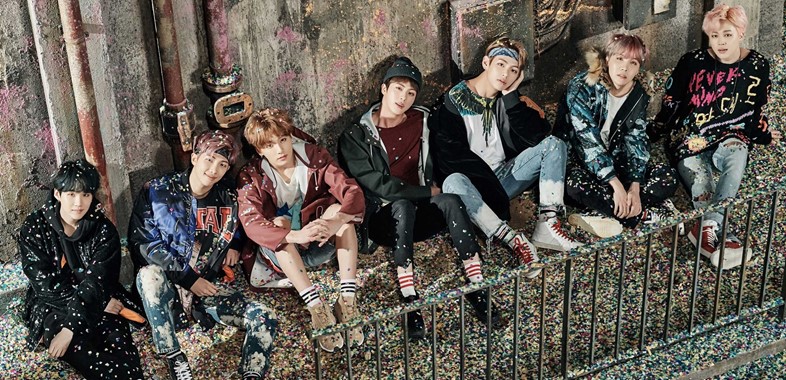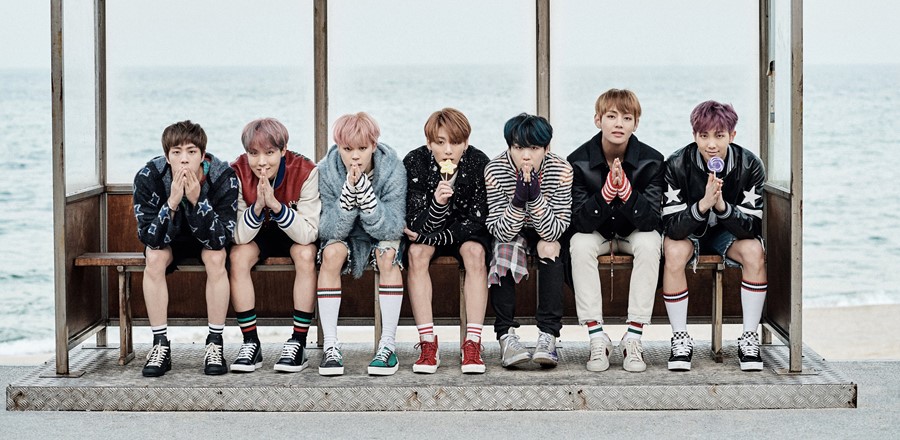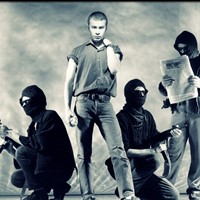In just four short years the seven-piece band have amassed an obsessive fanbase, derailed Korea’s ‘Big 3’ record labels and become the country’s most prominent act to break the west
Since their legions of fans, known most simply as A.R.M.Y. (‘Adorable Representative M.C. for Youth’), propelled them to snatch Best Social Act from under the nose of Justin Bieber at the Billboard Awards in May, the seven members of South Korean group BTS – rappers Rap Monster, J-Hope, and Suga; vocalists Jimin, Jin, Jungkook, and V – have been covered slavishly by publications from Vogue to Allure, Forbes to People, making them easily the most prominent Korean act in the west since PSY broke through way back in the wilderness of 2012 with “Gangnam Style”.
They may still be regarded as an overnight phenomenon by an American media awed by the group’s social media muscle power, but even the tiniest peek behind the glittery curtain shows how ferociously BTS have dedicated themselves to nurturing a long-term symbiotic relationship between the group and their fandom. Those seven immensely likeable and robust personalities have been constantly channeled for over four years into a social media omnipresence via Twitter, a series of mini-shows (such as American Hustle, Bon Voyage, Run BTS!, and BTS GAYO) broadcast on a variety of online platforms, and hundreds of the behind-the-scenes YouTube videos known as Bangtan Bombs that capture the mundane side of stardom – endless dressing rooms, hotels, and travelling – and the mischief they make during that time.
It’s been an emotional journey during which they’ve created their own little online universe that’s a haven for the members and fans, dense with in-jokes and catchphrases (as well as a few trials and tribulations), a secret language that fans slowly pick up on the deeper they go into it. This intimacy has forged an unbreakable connection between BTS and A.R.M.Y. and translated into a steamroller of support that flattens other fandoms – but also prompted other groups to up their social game, from groups like Astro adopting BTS’s selfie-heavy approach to new boy group WannaOne aping the @BTS_twt Twitter account with @WannaOne_twt.
Of course, none of this would command people’s attention if it weren’t for BTS’s stellar creative output, which is just as personal as their off-stage presence. Their self-penned lyrics can be frank and raw, while their music both experiments with and merges genres from hip hop to rock, EDM to future bass, and the accompanying videos contain rich storytelling around social realism, which have helped establish a new standard for K-Pop visuals.
Everything about BTS’s immense impact is felt more keenly simply because they were never expected to succeed at all, let alone challenge K-Pop’s status quo, where groups from the big entertainment companies rule the roost and those from smaller companies, like BTS, fill in the gaps. Even up until as recently as last year, BTS were viewed by the industry as underdogs and outliers, something they appeared to embrace and make part of their identity – even if only to loudly smash that status against the platinum records they’re chalking up.
With 16 video singles to date, BTS’s catalogue is overflowing with memorable work that’s set them apart from their contemporaries. Here, we look at five major milestone videos that helped define the group’s singular, unstoppable rise to pop royalty.

THE ONE THAT STARTED IT ALL: “NO MORE DREAM” (2013)
Looking back at BTS’s 2013 debut, it’s amazing just how young they look – Jungkook was a mere 15 years old at the time. And the amount of Hood by Air and KTZ sported by the group is impressive. The track heralded BTS as ‘hip hop idols’, a concept they weren’t necessarily alone in (the groups B.A.P and Block B, who both mix talented rappers and vocalists, had debuted in 2012 and 2011 respectively and, like BTS, had plenty to say). But “No More Dream” batted hard, railing against fulfilling a traditional, 9-to-5 future, and the hypocrisy of those against dreaming big when they were without aspirations of their own.
The MV (music video)’s set design, featuring skate ramps, classrooms, and graffiti, was overstuffed but effective in setting the scene for the first part of BTS’s ‘school trilogy’ series, and the group were, despite their age and rookie status, irresistibly self-assured, able to command attention despite the frenetic backdrop. The song still holds up thanks to its brooding double bass and melodic hooks, and was performed live in full until this year’s WINGS tour, which gave them ongoing opportunities to enhance the track with the strength of a self-fulfilled prophecy and a dance break that’s become the stuff of legend.
At the time “No More Dream” marked them as a group to watch, and even now it remains a colour-saturated goldmine – the attitude-filled introduction, V’s iconic spectacles flick, Suga’s sarky line “I wanna big house, big cars and big rings”, and Jungkook’s still-excellent move of hoisting Jimin horizontally to run along the backs of standing members.
THE ONE THAT CHANGED THE GAME: “I NEED U” (2015)
As they headed for their third year, BTS had a solid fanbase but hadn’t yet cracked the mainstream – but “I Need U” was their precipice moment. It took them from the upbeat pop/hip hop sound and the playful vibe of singles like “War of Hormone” and plunged them into high drama and heartbreak with lashings of electro and a lavish chorus.
As the beginning of the two-part album saga 화양연화 (Hwayang-yeonhwa), or The Most Beautiful Moment In Life, you can practically see and feel the group’s tectonic plates shift into perfect alignment. Having a long-term production team and a corresponding flow of ideas and goals between group and management meant that “I Need U” felt more like the group were exploring new ground in a natural way rather than radically shifting to pursue success. Lyrically, it’s a straightforward break-up track, but its power lies in the charged vocals and rounded arrangement – not to mention, of course, a video that hit you right in the gut.
This, the original version, is a visual feast of disenfranchised youth, like The Outsiders for the 21st century. The muted palette makes the joyous moments tender and the despairing and violent ones dreamlike, while the storyline – weighted with allegory, and spawning thousands of fan theories – drew in swathes of new, curious fans. The narrative continued through “Prologue”, “Run” and, finally, “Epilogue: Young Forever” to create an enviably dense video canon, helping spawn a ‘trilogy’ trend used by contemporaries like GOT7 and MONSTA X.
THE ONE THAT DOUBLED AS A HOLLYWOOD BLOCKBUSTER: “FIRE” (2016)
Some may argue that “Dope”, with its faux-one take cinematography and feisty aim-for-the-stars lyrics, might well take this slot, but “Fire” is BTS’s dichotomy – their fearlessness, star status, and large-scale execution versus their sweetness and earthy humour – made real.
“Fire” is both intimidating and reassuring: in the split-second following Suga’s laconic “불타오르네” (“it’s burning”), it explodes into a hurricane of floor-destroying bass, synths, and clattering snare rolls, like stadium rock fed through a 24-hour rave, clothed in Saint Laurent and choreographed within an inch of its life… and then there’s V ironing Jin’s shirt, with Jin still in it. It’s a lesson in how to make a music video that doesn’t take itself seriously but means business – it turns the charm dial to kill mode with the winks, smouldering stares, and lip bites, sets everything alight and drops cars from cranes like it’s gunning for a Michael Bay medal of flamboyant destruction, yet frames the song’s rallying call to arms and one of their most brutally precise dance routines with a laser focus.
It’s on the live stage where “Fire” can hit hardest – their performance at the 2016 MAMA awards was like all the air being sucked from your lungs, a visceral, career defining moment where those that weren’t convinced that BTS had become one of the most important groups in K-Pop could doubt that no longer.
THE ONE THAT SENT THEM STRATOSPHERIC: “BLOOD SWEAT & TEARS” (2016)
Tropical house may have been a global trend that K-Pop came late to, but BTS jumped on it for “Blood Sweat & Tears”, combining elements of the genre with the more hyped-up sounds of moombahton for a song that was sexy yet cerebral, and that completely stepped off the path they’d so carefully carved. From the gritty, everyman reality of “I Need U” and “Run”, BTS now found themselves in a baroque fantasy of blindfolds and absinthe – and even if you didn’t care that it borrowed its story from Hermann Hesse’s 1919 Jungian fiction Demian, you could be seduced by the sinuous choreography, extravagant sets and careful close ups that celebrated every inch of their handsome visages.
“Blood Sweat & Tears” was a step forward mentally, physically, and emotionally, a break-up song that flung itself into the abyss where the dark lyrics were juxtaposed by the gold dust of the monster hook. Moving away from the angsty teenage kicks of their previous two albums was a risk, but this is a group whose entire career has been spent proving people wrong. So it was gleefully thrilling that “BST” and its parent album WINGS scored a clutch of South East Asian-based Best Album, Best Video, and Best Male Group music awards, spattered in the shock of fandoms who couldn’t quite believe a group from a small company could derail the tradition of wins by K-Pop’s ‘Big 3’ entertainment agencies (YG Entertainment, SM Entertainment, and JYP Entertainment).
In its wake, and despite “BST” being released last October, trop-house has become ubiquitous in K-Pop, with track after track still seeking the same chart-topping alchemy and the trend showing no sign of fading away.
THE ONE WHERE THEY BECAME TRULY BULLETPROOF: “NOT TODAY” (2017)
However tempting it might be to simply list the brilliant Bangtan Bombs, trailers, and .gifs that have accumulated around BTS (such as 2015’s unmissable tour intro, where, dressed as naval officers, they bust knife-edge moves to Krizz Kaliko and Limp Bizkit) for this final entry, we come full circle to their most recent original release.
Like “Fire”, “Not Today” is epic in scale, with a lumbering bass, whooshing airy rises, and a stuttery, dominating chorus. It’s what BTS can do so effortlessly – a multi-layered piece that feels cinematic yet intimate (in this case, through indirectly referencing their A.R.M.Y. in the lyrics and dropping in parts of fan favorite “뱁새 (Baepsae/Silver Spoon)” into the mix). “Not Today” intriguingly presents the group as both vulnerable and powerful, for although highly celebrated and beloved by millions, they’re aware that their every move is being watched by anti-fans and rivals. Thus the scenes mimicking the fatal charge in war movies like Gallipoli are juxtaposed by their ‘resurrection’, and the inspired overhead shot that captures BTS in a flying V-formation, surging ahead. If anything, “Not Today” isn’t just a declaration of non-surrender to the uglier side of success, but a vow to not be contemplative of their enviable position.
As the final single from the WINGS era, it was a confident and confrontational video to release right before they stepped into the secular confines of touring, like a middle finger kiss-off farewell. However, now fully bathed in the glare of the global spotlight with much riding on upcoming material, “Not Today” feels more important – a decisive and fierce springboard that signals that whatever corner BTS turn next, it’s for themselves first and foremost. Their upwards trajectory has been set, whether you’re on board or not.




